This post is part of a draft on palaeolinguistics and the Proto-Uralic homeland. See below for the color code of protoforms.
3. Forests
3.1. Regular terms
PU (Saa.? Fi., Md., Ma., Ms., Hu.? Smy.) *kojwa ‘birch’ (UEW Nº 334).
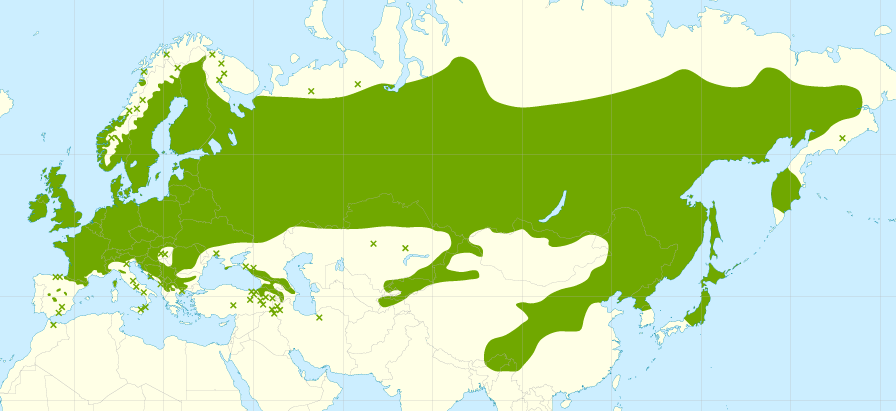
Native range.
✖ Isolated population.
Included heterotypic synonyms: B. verrucosa, B. platyphylla, B. szechuanica.
Image by Giovanni Caudullo (2017) at Wikipedia.
PU (Saa., Fi., Ma., P, Kh., Ms.) *ćänä ‘bracket fungus’ (UEW Nº 995; Aikio 2020: 115 with references).
PU (Md., Ma., Hu.) *ćalV/*će̮li/*ćälV ‘elm’ (UEW Nº 926), from PMd. *śäľǝŋ, PMa. *šolǝ, Hu. szil (Aikio 2020: 101 with references).

PU (Saa., Fi., Md., Ma., P, Kh., Ms., Smy.) *kowsi/*kusa ‘spruce; fir’ (UEW Nº 429, Aikio 2020: 46 with references).
P(C)U (Ma., P, Ms., Kh.) *ńulka/*ńulki ‘fir’ (UEW Nº 646; Pystynen 2017).
Based on their (partly similar) distribution and meaning, it is unclear what the original difference between both words might have been. *kowsi was borrowed from PSmy. into Turkic (as ‘spruce’ or ‘Siberian pine’) and Mongolic (as ‘spruce’), but PGmc. *gis-nó ‘pine tree’ and PCel. *gis-usto-? ‘pine’ were probably borrowed from West Uralic, cf. PFi. *kuusi (Kroonen 2013: 289-290).
NOTE. The following map is only from the European variety, to delimit the potential Uralic homeland to the west, since various tree species can appear in most regions of Northern Asia (except for the Arctic circle). Nevertheless, depending on climatic variables, the habitat suitable for A. alba – the European silver fir – can improve drastically, including most of Ukraine and parts of European Russia and the Caucasus (see Tinner et al. 2013), so – without a precise evaluation of climatic variables per age – it essentially excludes the steppe.
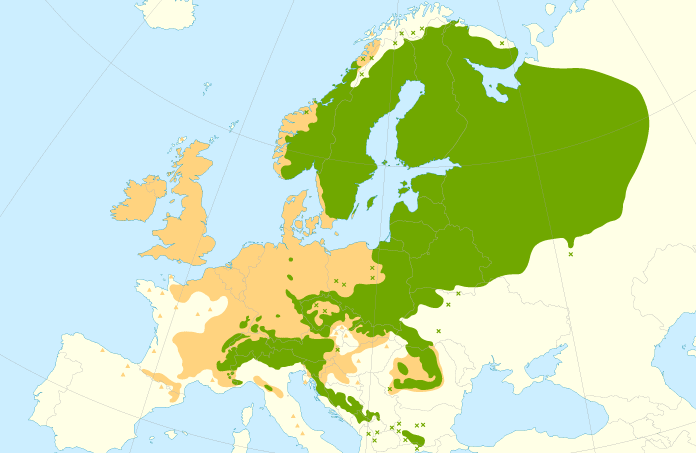
Native range and ✖ isolated population.
Introduced and naturalized (synanthropic) area and ▲ isolated population.
Image by Giovanni Caudullo (2017) at Wikipedia.
PU (Fi., Md., Ma., P) *piśla ‘rowan’ (UEW Nº 746; Pystynen 2017).
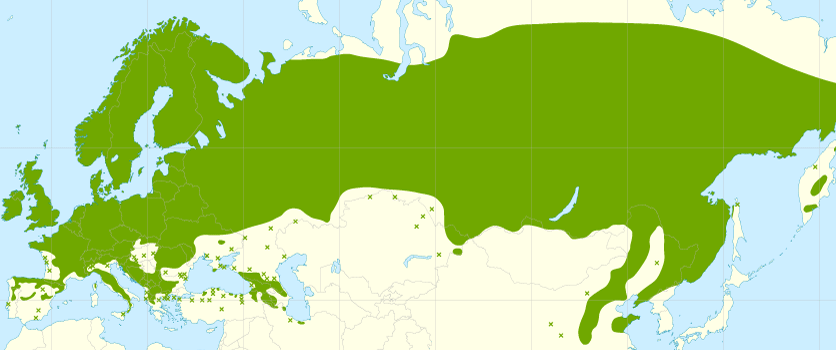
Native range.
✖ Isolated populations.
Image by Giovanni Caudullo (2016) at Wikipedia.
PU (Saa., Fi., Md., Ma., P, Kh., Ms., Smy.) *ďe̮mi ‘bird-cherry’ (UEW Nº 122, Aikio 2019).

PU (Fi., P, Kh., Ms., Smy.) *mura ‘cloudberry, cranberry, knotberry; Rubus chamaemorus’. Wide distribution of the different species in cool temperate zones of North Eurasia. The following map offers assumed modern wild zones for Vaccinium oxycoccos (for a wider distribution of cranberries in general, see e.g. Wikipedia). Possibly borrowed into West Indo-European dialects, cf. Gk. μόρον (?→ Lat. mōrum (?→Welsh merwydden ‘mulberry’)), Arm. mor (Bjørn 2017: 97), or both from a third source.
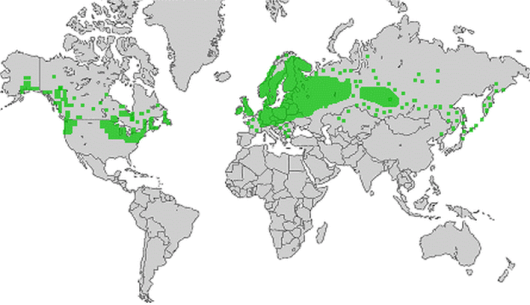
PU (Saa., Fi., Md., Ma., P, Smy.) *pe(n)čä ‘pine’, cf. also here Nganasan hiδiḿďə (Normanskaya & Dybo 2010). Compare also the almost complementary distribution of PEU (Kh., Ms., Smy.) *juwV ‘pine’.
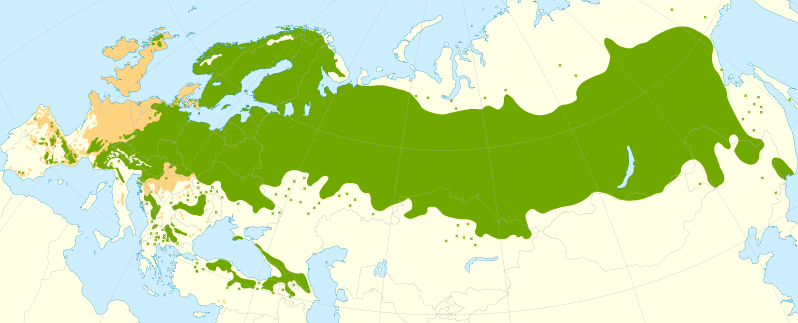
Native range and ✖ isolated populations.
Introduced and naturalised (synanthropic) area and ✖ isolated populations.
Included heterotypic synonyms: Pinus hamata.
Image by Giovanni Caudullo (2017) at Wikipedia.
“Siberian pine”?
Particular attention merits PU? (Ma., P, Kh., Ms., Smy.) *se̮ksa/*soksa, defined as “Pinus sibirica, Pinus cembra” in UEW (Nº 903). Aikio (2020: 46 with references) justifies the location of the Proto-Uralic homeland on Siberia based on this particular word, and Saarikivi (2020: 72) also mentions it as part of the evidence for a “southern taiga zone origin of Proto-Uralic”.
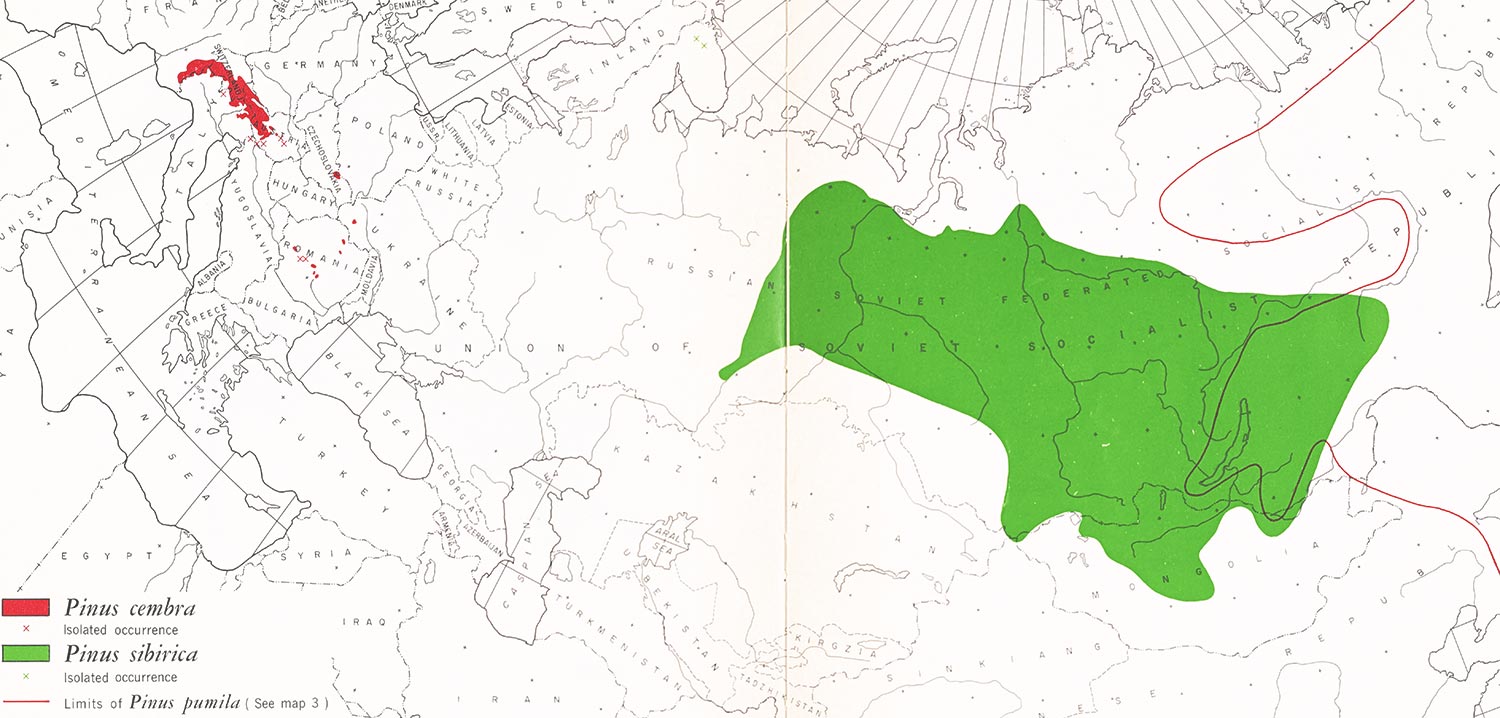
Of course, since there is no “Siberian pine” proper to the west of the Urals, the word has another meaning outside of its range: cf. PMa. *saksV? in Mari KB šaršə̑ ‘Acer fruit’, V sas ‘id.’, JT šoršo ‘id.’ (see maple distribution above); and even within its range, cf. Udmurt P susi̮-pu ‘Juniper bush; juniper’ MU su̇si̮-pu ‘juniper; Ericaceae bush’ G susı̣̑-pu ‘ibid.’ (see juniper distribution below). Leaving the irregular Mari forms and semantics aside leaves us with a word limited to the Urals and Siberia, and even there with not a fully regular shape or delimited meaning, which is especially noticeable in the case of Udmurt, a language historically well within the range of Pinus sibirica.
NOTE. In fact, the distribution of Pinus cembra (usually considered together with Pinus sibirica) has included traditionally a good part of the eastern slopes of the Ukrainian Carpathians, and this distribution might have been greater depending on the specific palaeoclimatic conditions, which makes any interpretation about the homeland location based on this particular tree even less distinctive.
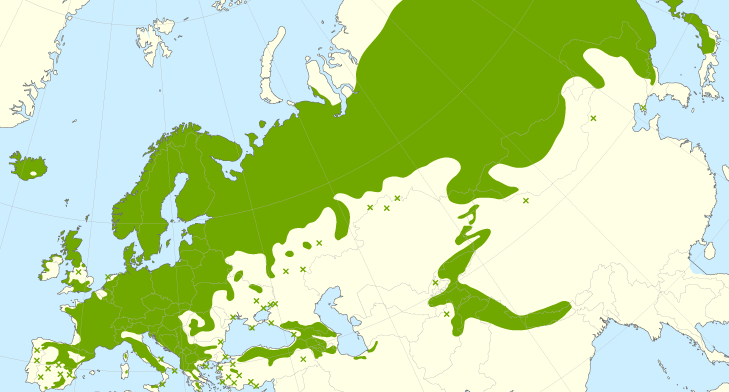
Native range.
✖ Isolated population.
Image modified from Giovanni Caudullo (2017) at Wikipedia.
A similar case is found in PU (Saa., Fi., Kh., Ms., Smy.) *nakris, defined by the editors of the UEW (Nº 584) as “cone of Siberian pine”, but whose actual meanings range from PFi. *nakris ‘turnip; root vegetable’ (same meaning in Saami) to Ob-Ugric *nëëɣər ‘pine nut’ (a meaning also found in Smy.). Its phonology is also irregular.
Furthermore, PU? (P, Kh.) *jakkV ‘pine forest, spruce forest; Ericaceae bush’ (UEW Nº 159), has a similarly wide meaning range and word distribution around the Urals, which shows how certain species are naturally bundled together (for another example, see ‘spruce’ above).
Similar cases are also found in many other words defined in UEW, such as *lujV ‘pine marten; Mustela martens’ (UEW Nº 494, see above) which – if followed literally – would exclude the sable distribution that is proper of the animal described in Samoyedic cognates… All in all, based on linguistic reasons alone, it is difficult to understand the interest in attributing the meaning ‘Siberian pine’ to the parent language, and still less the interest in focusing on this irregular word of limited attestation for the location of the Proto-Uralic homeland.
3.2. Agricultural substrate
PFP (Fi, Md., Ma., P) *tammi ‘oak’ (UEW Nº 1649), assumed by Zhivlov (2015) to belong to the Agricultural Substrate. From OP tu-pu (← *tum-pu), Udm. ti̮-pi̮ (← *ti̮m-pi̮ ← *tum-pu), likely borrowed as substrate into PSlav. *dǫbъ (Witczak 2020: 74).
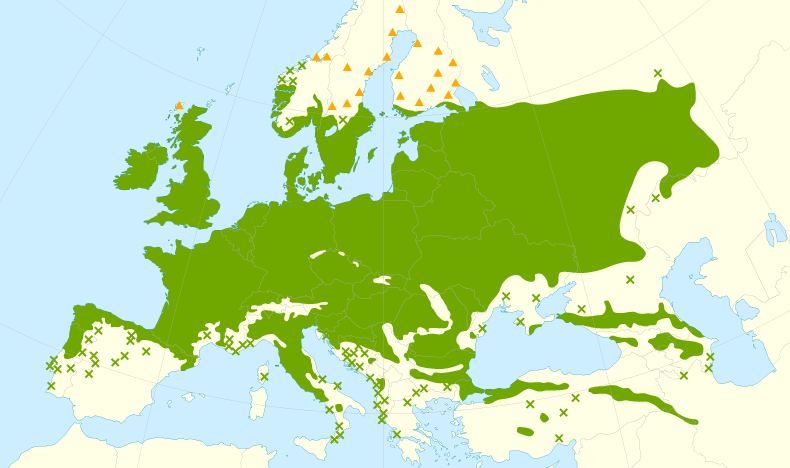
Native range.
✖ Isolated population.
▲ Introduced and naturalized (synanthropic).
Image by Giovanni Caudullo (2017) at Wikipedia.
PFP (Saa., Fi., P) *jekäl/*jäkälä ‘lichen’ (UEW Nº 1242), suspected by Aikio (2015: 46) to belong to the Agricultural Substrate based on its “distribution, meaning and phonological irregularity”(?).
PFP (Saa., Md.) *luppV/*nuppV ‘beard lichen’ (UEW Nº 1393), suspected to belong to the Agricultural Substrate based on irregular correspondences (Zhivlov 2015).
PFU (Saa., Fi., Kh.) *piška ‘resin’ (UEW Nº 776). Based on the reconstruction of an *š, possibly an Agricultural Substrate word, but with a widespread distribution in Uralic.
PFP (Fi., Md., Ma.) *päkšnä ‘linden tree’ (UEW Nº 1740). The word shows a unique cluster correspondence PFi *hn ~ PMd *kš (MdE pekše, M päšä) ~ PMari *st, which could be resolved by postulating the three-consonant cluster *kšn, an anomalous cluster in Proto-Uralic phonotaxis (Aikio 2015: 43; Zhivlov 2015).
PFP (Fi., Md., Ma.) *lem(e)šV ‘(young) linden tree’ (UEW Nº 1376), suspected to belong to the Agricultural Substrate based on irregular correspondence *lewVš-, *nemVš- (Zhivlov 2015). If interpreted as a suffixed *leme-šV, possibly comparable to Northern European *len-t- ‘linden tree’, behind Pre-Gmc./PBal. *lenta, Pre-PSlav. *lontjo-, of likely substratal origin (Kroonen 2013: 338).
PFP (Saa ← Fi., Ma., P) *nini (*ńini) ‘bast, lime bast’ (UEW Nº 1428), possibly borrowed into PCel. *nino- ‘ash-tree’ (cf. de Smit 2019: 8).
The absence of cognates for these words around the Northern Urals and in Siberia seems roughly correlative with the general absence of the lime-tree in those regions.

PFP (Fi. Md., Ma.) *wa(k)štira/*wa(k)štara ‘maple’ (UEW Nº 1683; Häkkinen 2009: 38; Aikio 2015: 45 with references). Similar case as that of ‘linden’ above.

Image by Giovanni Caudullo (2017) at Wikipedia
PFP (Fi, Md, Ma, P) *päški(nä)/*päšti/*päkši ‘hazelnut’ (UEW: 726–727; Aikio (2015: 45).
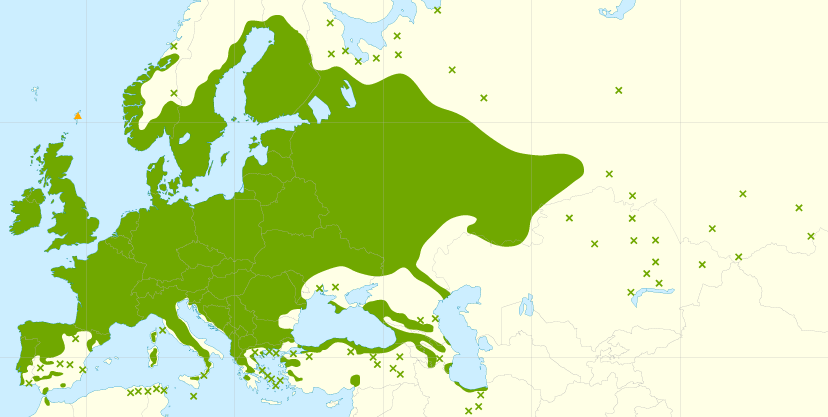
Native range and ✖ isolated population.
▲ Introduced and naturalized.
Image by Giovanni Caudullo (2017) at Wikipedia.
PFU (Md., P, Kh.) *poji ‘aspen’ (UEW Nº 787; Pystynen 2017). Compare the complementary distribution of PFP (Saa., Fi., Ma.) *šuwpa /*šaxipa/*šapkV ‘aspen’ (UEW Nº 1609; Aikio 2015: 45; Zhivlov 2015). A species with a wide range in Eurasia.

PFU (Md., Ma., P, Kh., Ms.) *äŋäńćV ‘raspberry’ (UEW Nº 46; Aikio 2020: 39 with references), suspected by Aikio (2015: 46) to belong to the Agricultural Substrate based on its “distribution, meaning and phonological irregularity”(?). Maybe a compound from an original PU **äńćä ‘(rasp)berry’ (Pystynen 2019).
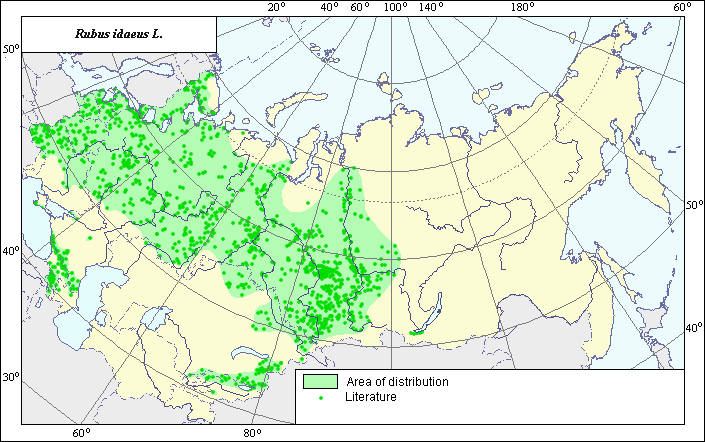
4. Climate
4.1. Cold and Snow
PU? (Saa. Fi. Md. Ma. P) *lumi ‘snow’ (UEW Nº 496), also here PSmy. jom-, Hu. lom (Pystynen 2017).
PU (Saa., Fi., Md.?, Ma., P, Kh., Ms.?, Smy.) *purki ‘snowstorm, blizzard’ (UEW Nº 819).
PFU (Ma., P) *pe̮śi ‘mitten’, cf. PMs. *pɨɨsɣaa, PKh. *paas (Pystynen 2017).
PFU (Saa. Fi., Md., Ma., P, Kh., Ms., Hu.) *jäŋi ‘ice’ (UEW Nº 171).
PFP (Fi., P) *pura ‘ice pick’ ← *pura ‘drill’ (UEW Nº 817; Pystynen 2017), most likely parallel developments in Fi. and P from a more general meaning in the parent language, based on its absence in dialects with more continuous contact with ice.
PU (Saa., Fi., Md., Ma, Kh.) *jäkši- ‘cold’ (UEW Nº 165; Aikio 2015; 2020/forthcoming). Based on the reconstruction of an *š, suspected to be Agricultural Substrate word, but with a widespread distribution in Uralic.
PWU (Fi., Md.) *šumar/*šuwar ‘snowdrift; melted snow; ice crust’ (UEW Nº 790), suspected to belong to the Agricultural Substrate (Zhivlov 2015).
PFP (Saa., Fi., Md., Ma., P) *kilmä (*külmä) ‘cold’ (UEW Nº 1311) ←?? (Pre-)PBSl. **g(ʷ)el(u)mā, cf. Lith. gelumà (Koivulehto 1983).
NOTE. Despite the traditionally proposed derivation from PIE *gel- ‘be cold, freeze’ (cf. Lat. gelus ‘frost’), the Lithuanian form possibly belongs to the group gélti ‘sting’ (ALEW 352-353), cf. Lith. gėlìmas, gė́limas ‘sting, sharp pain’, and gélmenis ‘piercing cold’, which renders the borrowings in the proposed direction less likely.
P(C)U (Ma., P) *käśV- ‘to freeze’ (UEW Nº 1276); cf. also PSmy. *kənsə- (Aikio 2002).
PU (Saa., Md.) *sumV/*suwV ‘(light) fog’ (UEW Nº 1576), suspected to belong to the Agricultural Substrate based on irregular correspondences (Zhivlov 2015).
Pre-Saa. *ćarmis ‘hail’ ← PBSl *śarma-, cf. Lith. šarmas ‘hoarfrost’ (Koivulehto 2003: 297; Koivulehto 2006: 188–89).
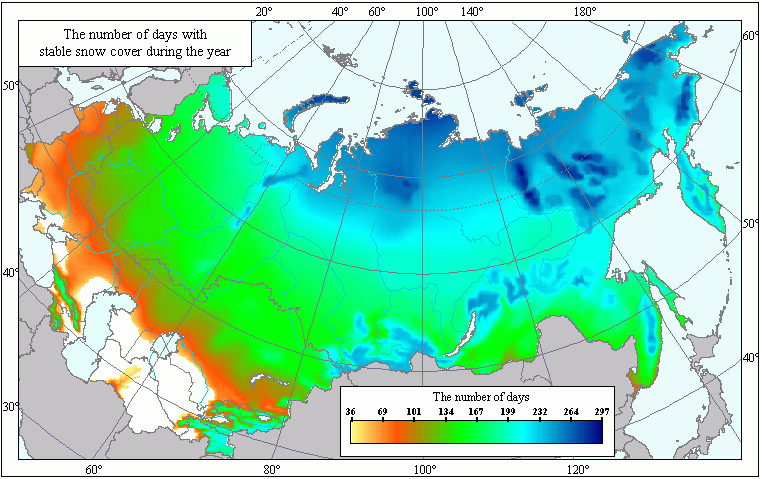
4.2. “Shoes” or “Skis”?
PU (Fi., Md., Kh., Ms., Smy.) *suksi/*soksa ‘snowshoe; ski’ (UEW Nº 912). To this family of words belong also the dubious **je̮či? (UEW Nº 204), **lampa? (UEW Nº 453), **kowti? (UEW Nº 1337), or **saji(-ki)? (UEW Nº 869).
An early adoption of a PFP (Saa., Md., Ma., P) *kämä ‘shoe; boot’ (UEW Nº 1281) ← PIE *kama- (or Pre-PIIr. *k(ʲ)ama-? cf. Skt. śāmūla-, śāmuljà- n. ‘shirt’) might have restricted an ‘original’ PU word for ‘shoe’ to the field of ‘snowshoes’ and ‘skis’. Koivulehto (2007) proposed an origin in the Pre-PGmc. form from the same root (cf. *kʰama(n) ‘shape, physical form; covering’), which seems unlikely based on its wide distribution among Uralic dialects (unparalleled in Germanic loanwords).
NOTE. PFP? (Saa., Md.) *šamo/*šimo ‘shape, figure’ (UEW Nº 782), suspected to belong to the Agricultural Substrate based on irregular correspondences, has also been compared to the same Pre-PGmc. form (Zhivlov 2015).
PU/PFU (Saa.?, Fi., Kh., Smy.?) *aški ‘sledge’ (UEW Nº 32), possibly a substrate word.
PU? (PSaa., PMs., PSmy.) *ćona/*śona? ‘sled’ (UEW Nº 976). A similar word occurs in North Eurasian languages: cf. PSlav. *sanь ‘sleigh, sledge’ (borrowed into Fi. and Hu.) ← PBSl. *śaˀnos/*śaˀnis (cf. Lith. šónas ‘side, flank’, Latv. sãns ‘side’), without IE cognates (Derksen 2015: 454); cf. also Tatar čana, Chuvash śuna, śona; Mongolian čana ‘sleigh, sledge’. The direction of borrowing is unclear.

It is particularly striking that there are no clear reconstructs for ‘shoe’, ‘boot’, or ‘sled’, but there are one certain and many other irregular ones for ‘ski’, which is reminiscent of the “taciturn hunter-gatherer” paradox, where PU speakers apparently only wore skis, and had just the occasional need for shoes, boots, and usual transportation means through snowy areas…
Based on the likely late meaning and adoption of these words, the most parsimonious explanation is that there were multiple regional specializations of general vocabulary to a daily life in more snowy areas, as new borrowings for foot wear appeared in the different dialects. The assumption in Aikio (2019: 47) or Saarikivi (2020: 72) that “skis” were a mode of transportation for PU speakers cannot hold based on lexical data alone. Even though archaeologically it is not far-fetched to assume that skiing was known in the Proto-Uralic-speaking area – wherever it actually was – it is much more likely that these words referred originally to ‘shoe’, ‘boot’, or ‘snowshoe’ in general, and gradually specialized its meaning to ‘ski’ among communities who practiced it.
NOTE. Nevertheless, even if a word specifically used for “ski” could have existed in the parent protolanguage, the reference to a dubious (Saa.?, Fi., Ma.?, P?) *sompa ‘stick, rod’ (UEW Nº 1568) as a PU word for “rim in the lower part of ski pole that prevents it from sinking too deep” in Saarikivi (2020: 72) does not make any sense, based on its phonological irregularities, differences in meaning, and limited distribution.
Rock carvings including skiing are present (at least) since the Mesolithic in West Scandinavia, and since the sub-Neolithic in Eastern Fennoscandia (Janik et al. 2007), but arguably also as far east as the Altai. Ski remains have been found dating to the Mesolithic in Norway, and probably also in the Northern Dvina Basin. Snowshoeing must have been commonplace in regions frequently covered by snow since prehistory, as the shoes of Ötzi – and even earlier finds from the Alps – and Iron Age references from the Caucasus suggest. In more temperate areas, it is essentially impossible to find archaeological remains of wood or other organic tissues, though.
Palaeoclimate and Palaeoforests
It doesn’t take much research to realize what the main problem is, when researchers try to locate an Urheimat based on words referring to nature. Even considering linguistics alone would be enough, if one cared to examine the paradigmatic experience of Indo-European studies during the 20th century, when words related to nature have been indiscriminately used to support all kinds of homelands: from West to South and North Europe (including the East Baltic), from Anatolia to Iran and the Caucasus, and from Siberia to South Asia.
The key restriction should be offered, indeed, by palaeoclimatic studies. Even having (1) a seamless phonological reconstruction of (2) widely available Uralic words (3) distinctly referring to specific species and climate-related tools, unless and until there were an accurate and comprehensive atlas of palaeoclimate and palaeoforests divided by age, attempts to find a precise homeland based on them is a futile task. Let alone trying to use them without understanding the whole picture offered by palaeolinguistics, archaeology, and population genomics.
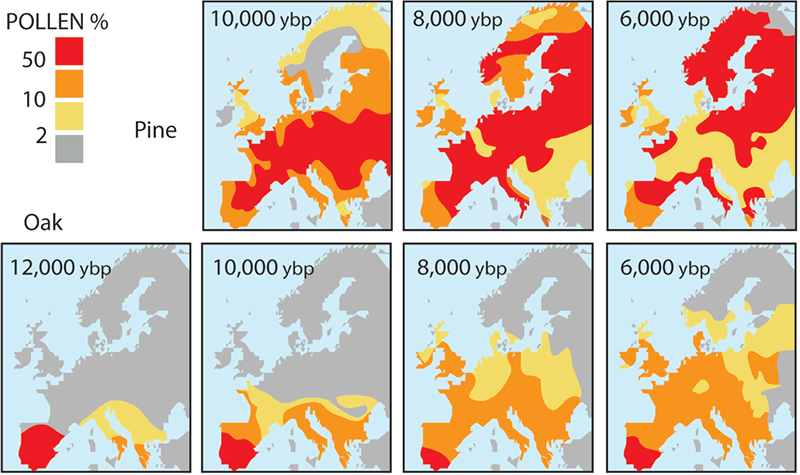
From the book Third Millennium BC Climate Change and Old World Collapse (1997), by Dalfes, Kukla, and Weiss (Eds.):
Climate was less continental than at present ca 6000-4500 BP. In steppe belt January tº was 1°C higher than today, July tº was 2° lower, annual precipitation was 100-150 mm higher as compared to the modern level.
Floodplain and valley forests were the most widespread in the Dniestr, Dniepr, southern Bug, Don and Volga River valleys. Broad-leaved trees penetrated farther to the south as compared to their modern southern limits [figure below]. Pollen of Carpinus betulus is registered in the Volga River ox-bow section near Solenoye Zaymischevillage (47°54′ N, 46°09′ E) (Bolykhovskaya, 1990). That fact proves that the hornbeam area expanded in the south of Eastern Europe. Steppe cover became more mesophytic, an amount of meadow elements in steppes increased. Forest area expanded also in the forest-steppe belt of Ukraine and Russia (Artiushenko, 1970; Gerasimenko, 1993; Spiridonova, 1991).
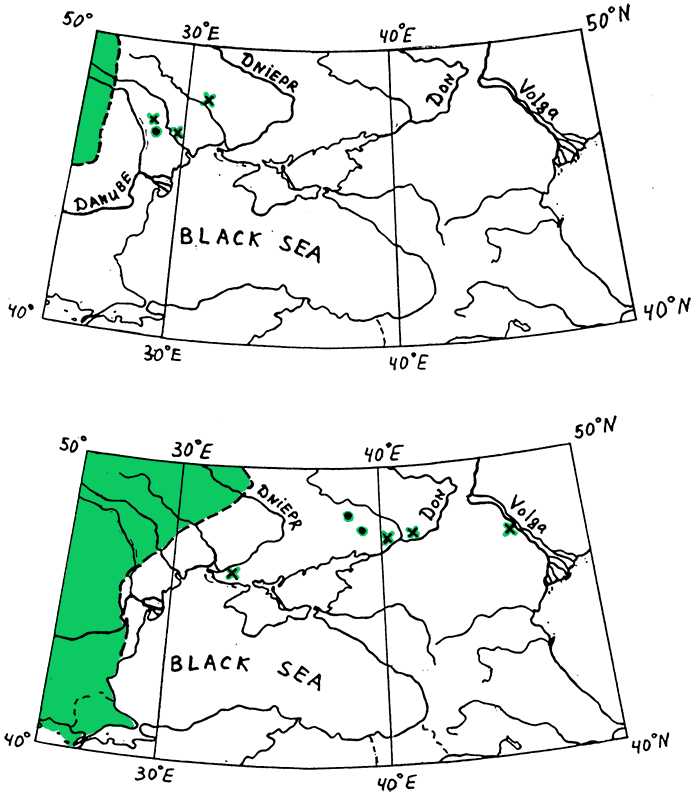
—- – modern limit of the beech Fagus sylvatica L.
• – isolated site of beech Fagus sylvatica L.
x – finds of beech Fagus sylvatica L. pollen
Bottom: Late Holocene finds of hornbeam pollen outside limits of the modern range of hornbeam Carpinus betulus L. in Ukraine and Southern Russia
—- – modern limit of the hornbeam Carpinus betulus L.
• – isolated sites of hornbeam Carpinus betulus L.
x – finds of hornbeam Carpinus betulus L. pollen
Pollen analysis of the Kharabuluk peatland in the north of Kalmuk region (47°46′ N, 44°26′ E) shows that 6000-4700 BP was the time of increased forest area in the Yergeni low hills (47° N, 45° E) in north of Kalmuk region.
Sharp climatic changes occurred also during Subboreal period. After 4500 BP the climate became more arid and continental. In south-western Ukraine a share of Ulmaceae in forests seriously decreased. Thermophilous submediterranean species of oak and linden disappeared from the southern part of Volyn Lowhills in west Ukraine. Forest area decreased and steppe areas increased: The area of ravine woodlands markedly decreased in Kalmuk region ca. 4700-4500 BP. After 4500 BP some decrease of valley forest is evident for the lower part of Volga River valley (Bolikhovskaya, 1990). Within 4200 and 3700 BP was a maximal aridity of climate. In the steppe zone at that epoch there was 50 mm less precipitation than nowadays (Kremenetski, 1991). Grass steppes replaced grass-meadow steppes inthe low and
middle part of the Don River basin; and the area of valley forests considerably reduced.
NOTE. For the increasing aridization and expanding steppe biomes as a trigger of the spread of Yamnaya semi-nomadic pastoralists, see e.g. here. For more recent studies on the changing vegetation around the steppes, look e.g. for papers by Khokhlova.

Illustrative cases of the different Neolithic/EBA palaeoclimate and of tree names that do not exactly fit the steppe biome are found in terms such as ‘spruce’, ‘birch’, or ‘pine’, present in unrelated and distant Indo-European dialects, despite their paradigmatic homeland being evidently located on the steppes*. For example, compare PIE *peuk-i- in Gmc. *peuk-t-i- ‘spruce’, PBal. *peuk-i/puk-i, PGk. peukā ‘spruce’, and also Pre-PIIr. *peukʲ-i (cf. Waigali puč, püč ‘pine’) borrowed into Arm. tՙeł-awš (Kroonen 2013: 139); or PIE *bʰergʰ- in PGmc. *berkō-, Skt. bʰūrjá (Kroonen 2013: 61).
* We know this based on the combination with other vocabulary – central to their daily activities – as well as internal and external contacts, and a combination with archaeology and now also population genomics.
What is more, the fact that the guesstimates for Proto-Uralic coincide with a variable climate is also relevant for the distribution of animals. As we have seen above, the range of some mammals, birds and reptiles for which words have survived in modern Uralic dialects coincide with a more southern distribution than that of forests, so a worsening climate could mean that the range of certain animals was more southerly than it is today. Paradoxically, then, different climatic changes might expand or shrink the range of some tree, plant, and animal species to the north and south.
However, since nature hardly offers any solid argument for a homeland, it is best to just know of its limitations and move on to other, more relevant external constraints.
References
See full Bibliography.
Color code for protoforms
- certain | uncertain
- PU/PFU | PFP/PWU/PFS/PFV/PUg.| Dialects
- PIE (PIU?) | PIE? (PIU??)
- PIE/Pre-PIIr. (PIU??) | Pre-PIIr. | PIIr. | PIr.
- NWIE | Pre-PGmc./(Pre-)PBSl. | PGmc./PBal./(Pre-)PSlav.
- Substrate | Substrate?
- Agricultural: PU | PU? | PIE | PIIr.
- Geminates | Eurasian (Wanderwort?)
- Palaeo-European | Palaeo-Laplandic/Arctic
Return to the sections above: ↑ 3. Forests or ↑ 4. Climate.
Featured image: Erdal-Bilderreihe 23/375 Sammelbild – Die Michelsberger Jungsteinzeit Michelsberg Untergrombach, by Gerhard Beuthner (1937).